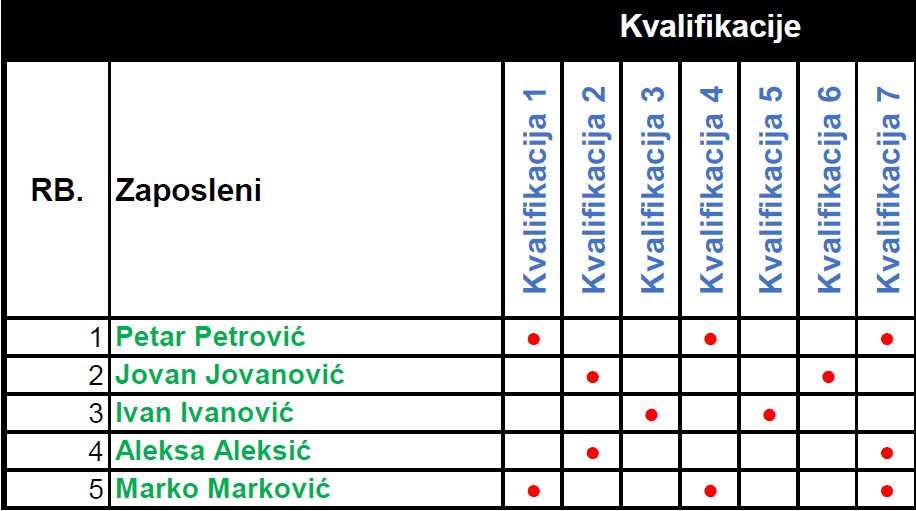Recently, there has been a lot of talk about the real impact of HR on business. It is a very comprehensive and important issue, often interpreted through modern headlines, sensational ideas, and innovations, but it certainly begins with a vision and the selection of the right people for the right positions at the right time. However, today we are talking about the development of people who are already in the company and who are faced with the changes imposed by the market as mandatory, those who are participants in technical and technological progress as well as advancements in the development of artificial intelligence. So, we are talking about people with a soul, not resources. To manage employees effectively, we need to get to know them, take care of them, and develop them, strive to provide the best possible working conditions, recognize their performance, and promote a sense of equal opportunities for everyone, while resources can be used by following the user manual and with regular maintenance.
Every manufacturing company pays the most attention to its production employees, as they are the ones who drive the “core” business, i.e., the production of goods, and they often make up the largest organizational unit. Due to the complexity of production facilities and automation, there are a wide range of positions that employees need to master. This is the ideal scenario, where employees can be assigned to the most needed positions during shift operations based on required production capacity and the availability of production resources.
Let’s focus on employee qualifications (skills), which is one of the first important aspects that must be regulated, addressed procedurally, and implemented. We define qualifications as the ability of an employee to perform the expected tasks correctly at a given position. For an employee to work in multiple roles, they must obtain the necessary qualification for each position by passing a combined test for acquiring technical skills (both theoretical and practical parts). The form sounds good, but it's not enough to get to the essence. To purposefully establish a system for acquiring technical skills, much more is needed than templates, texts, and procedures. It is necessary to get to know the job position, update job descriptions, create a vision of organizational efficiency, adjust the organizational design, and then, together with the production managers, determine the exact skills required for an employee to work at a specific position. The goal is to create a two-dimensional matrix of technical skills to facilitate the monitoring of employee expertise and, of course, to support their development. A third dimension of the matrix, which is not shown in the table, could be the assignment of employees to shifts.

Employees acquire technical skills from internal trainers, who are the most skilled in their field and pass on their knowledge to younger colleagues or those who are on a career development path.
To facilitate employee rotation (assigning work to different positions) in production facilities, it is necessary to carefully create detailed job descriptions that include work in various roles within the plant, along with the acquisition of the required qualifications. This significantly reduces the operational workload for HR administrative colleagues and decreases the risk of injuries, as all employees undergo comprehensive training in safe and healthy work practices.
The system can function with well-balanced organizational efficiency aligned with market demands and sales plans, and the benefits are numerous, including:
The introduction of systems that bring real improvements is often met with numerous questions from those who are hesitant (60%) or resistant to change (20%). For this reason, performance management systems are added to the existing framework, creating a productive work environment, with material incentives based on key performance indicators of each employee or team, non-material motivation, recognition and promotion of employees' work, and providing feedback—all aimed at the continuous improvement of employee work and performance. This transparent approach fosters a mild competitive atmosphere, which is certainly a desirable aspect for those who wish to prove themselves. We love to compete.
The cycle continues with the annual evaluation of employees, where managers have the opportunity to assess their employees based on various competencies and to evaluate each individual's potential for further development. To identify employees who are candidates for a guided career path, we can use the "9-box" or "16-box" matrix (talent management tools) based on the assessed potential of employees. Career management for talents is carried out systematically, including specific internal technical skill training and, depending on the position level, soft skills training.
What about employees who are not able to acquire additional skills? We need to get to know the employee, understand their strengths and weaknesses, and based on that, provide them with a position where they will feel useful and bring added value to the team.
In addition to employee development, there are other HR systems that bring additional value to the company, such as strategic resource planning, succession planning, hiring the right candidates and finding a sufficient number of candidates, retaining good workers and ensuring their satisfaction, legal work security and compliance with the law, salary management systems, etc., which we will discuss in more detail another time.
Original article in Business Intelligence Review.